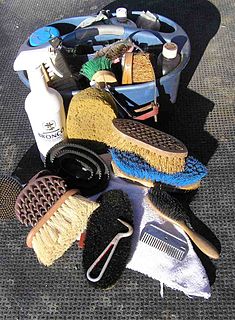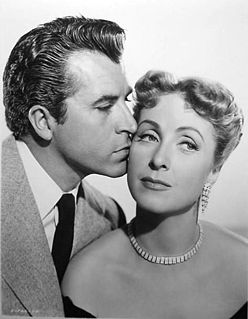
A hairstyle, hairdo, haircut or coiffure refers to the styling of hair, usually on the human scalp. Sometimes, this could also mean an editing of facial or body hair. The fashioning of hair can be considered an aspect of personal grooming, fashion, and cosmetics, although practical, cultural, and popular considerations also influence some hairstyles.

Denim is a sturdy cotton warp-faced textile in which the weft passes under two or more warp threads. This twill weaving produces a diagonal ribbing that distinguishes it from cotton duck. While a denim predecessor known as dungaree has been produced in India for hundreds of years, denim as it is recognized today was first produced in Nîmes, France.

Hair color is the pigmentation of hair follicles due to two types of melanin: eumelanin and pheomelanin. Generally, if more melanin is present, the color of the hair is darker; if less melanin is present, the hair is lighter. The tone of the hair is dependent on the ratio of black or brown eumelanin to yellow or red pheomelanin. Levels of melanin can vary over time causing a person's hair color to change, and it is possible to have hair follicles of more than one color on the same person. Some hair colors are associated with some ethnic groups due to observed higher frequency of particular hair color within their geographical region, e.g. straight dark hair amongst East Asians, a large variety of dark, fair, curly, wavy and bushy hair amongst Europeans, curly, dark, and uniquely helical hair with Africans, whilst gray, white hair or "silver", is often associated with age and wisdom.

Hair coloring, or hair dyeing, is the practice of changing the hair color. The main reasons for this are cosmetic: to cover gray or white hair, to change to a color regarded as more fashionable or desirable, or to restore the original hair color after it has been discolored by hairdressing processes or sun bleaching.

Hair mousse, also referred to as styling foam, is a hairstyling product to protect, stiffen, or style hair. "Mousse" originates from a French term meaning foam. Hair mousse originated in France and was brought to the North American retail market by L'Oreal in the 1980s, the first mousse product coming out under the label "Valence". It is often dispensed in an aerosol foam spray or in cream form. Hair mousse adds volume to hair and often provides both conditioning and hold, without any clumps or build-up. It is a hairstyling product which works by using synthetic resins to coat the hairs, to assist the hair in taking a certain shape. Hair mousse is purple while in the can and turns an off-white color upon coming in contact with the air. One of the lighter-weight hair styling products, hair mousse is applied to wet hair before drying and styling. Hair mousse can be used on naturally curly or permed hair too reduce frizz and define curl.

Clairol is an American personal care-product division of company Wella, specializing in hair coloring and hair care. Clairol was founded in 1931 by Americans Joan Gelb and her husband Lawrence M. Gelb, with business partner and lifelong friend James Romeo, after discovering hair-coloring preparations while traveling in France. The company was widely recognized in its home country, the United States, for its "Miss Clairol" home hair-coloring kit introduced in 1956. By 1959, Clairol was considered the leading company in the U.S. hair-coloring industry. In 2004, Clairol registered annual sales of US$1.6 billion from the sale of its hair-care products. As of 2014, Clairol manufactures hair-coloring products sold under the brand names "Natural Instincts", "Nice 'n Easy", and "Perfect Lights".
Artificial hair integrations, more commonly known as hair extensions, hair weaves, and fake hair add length and fullness to human hair. Hair extensions are usually clipped, glued, or sewn on natural hair by incorporating additional human or synthetic hair. These methods include tape-in extensions, clip-in or clip-on extensions, fusion method, weaving method, and wigs.

Hair care is an overall term for hygiene and cosmetology involving the hair which grows from the human scalp, and to a lesser extent facial, pubic and other body hair. Hair care routines differ according to an individual's culture and the physical characteristics of one's hair. Hair may be colored, trimmed, shaved, plucked or otherwise removed with treatments such as waxing, sugaring and threading. Hair care services are offered in salons, barbershops and day spas, and products are available commercially for home use. Laser hair removal and electrolysis are also available, though these are provided by licensed professionals in medical offices or speciality spas.
Nice ’n Easy is a shampoo-in permanent hair-colouring product for home use. It was introduced in 1965, billed as the first shampoo-in hair colour, with the advertising tagline, “The closer he gets...the better you look.”

Horse grooming is hygienic care given to a horse, or a process by which the horse's physical appearance is enhanced for horse shows or other types of competition.
Hair highlighting/lowlighting is changing a person's hair color, using lightener or haircolor to lift the level or brightness of hair strands. There are four basic types of highlights: foil highlights, hair painting, frosting, and chunking. Highlights can be any color, as long as it's a lighter level than the surrounding hair. Hair lightened with bleach or permanent color will be permanent until new growth begins to show. Highlighted hair can make the hair appear fuller. Therefore, it is sometimes recommended for people with thin and fine hair. It also a recommended service for achieving better color balance with people that have at least 50% gray, and it also helps to diminish the line of demarcation once the new growth is showing from permanent hair color.

Hair straightening is a hair styling technique used since the 1890s involving the flattening and straightening of hair in order to give it a smooth, streamlined, and sleek appearance. It became very popular during the 1950s among black males and females of all races. It is accomplished using a hair iron or hot comb, chemical relaxers, Japanese hair straightening, Brazilian hair straightening, or roller set/blowdryer styling. In addition, some shampoos, conditioners, and hair gels can help to make hair temporarily straight.
Color analysis, also known as personal color analysis (PCA), seasonal color analysis, or skin-tone matching, is a term often used within the cosmetics and fashion industry to describe a method of determining the colors of clothing and makeup that harmonize with a person's skin complexion, eye color, and hair color with the benefit of being able to use this tool for wardrobe planning and style consulting. Color analysis demonstrates how certain shades are capable of being flattering or, conversely, unflattering by observing the optical illusions that occur on the face when placing specific colors next to the individual. It is generally agreed that the wrong colors will draw attention to such flaws as wrinkles or uneven skin tone while harmonious colors will enhance the natural beauty of the individual making them appear healthy and fresh-faced.
Hairstyle products are used to change the texture and/or shape of hair, or to hold a hairstyle in place.

The 1950s were a decade known for experimentation with new styles and culture. Following World War II and the austerity years of the post-war period, the 1950s were a time of comparative prosperity, which influenced fashion and the concept of glamour. Hairstylists invented new hairstyles for wealthy patrons. Influential hairstylists of the period include Sydney Guilaroff, Alexandre of Paris and Raymond Bessone, who took French hair fashion to Hollywood, New York and London, popularising the pickle cut, the pixie cut and bouffant hairstyles.
Benoît Poirier d'Ambreville is a French stylist/colorist, entrepreneur, television celebrity, and former model. He was the runway consultant in the 2012 season of Chile's Canal 13's No Basta con ser Bella and is the image consultant on TVN's upcoming television program 21 días de lujo. He is the owner of the Atelier Benoît Poirier d'Ambreville in Santiago, Chile.
Ombré is the blending of one color hue to another, usually moving tints and shades from light to dark. It has become a popular feature for hair coloring, nail art, and even baking, in addition to its uses in home decorating and graphic design.
The granny hair trend is a new phenomenon of young women coloring their hair to different shades of gray. It emerged in the second decade of the 21st century.

The Curly Girl Method is an approach to hair care designed by author Lorraine Massey for natural hair that has not been chemically relaxed. This method discourages the daily use of sulfate shampoo, as it is too harsh for curly hair. Among other things, it calls for the use of a cleansing conditioner in place of shampoo, no silicones, the use of a diffuser when blowdrying, and no combs, brushes, or terrycloth towels. It also includes tips for using hair gel and other styling products. The aim in general is to treat naturally curly hair gently, minimizing damage to the hair cuticle; to keep it moisturized, since curly hair is more prone to dryness than straight hair; and, perhaps most significantly, to accentuate rather than interfere with the hair's natural curl pattern.

Box braids are a type of hair-braiding style that is predominantly popular amongst African people and the African diaspora. This type of hairstyle is a "protective style" and is "boxy", consisting of square-shaped hair divisions. Box braids are generally installed by using synthetic hair which helps to add thickness as well as helping the natural hair that is in the braid. Because they are not attached to the scalp like other similar styles such as cornrows, box braids can be styled in a number of different ways. The installation process of box braids can be lengthy, but once installed they can last for six to eight weeks. They are known for being easy to maintain.













